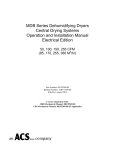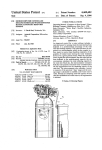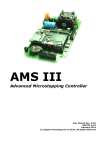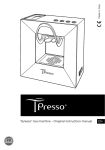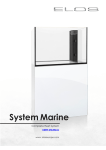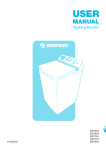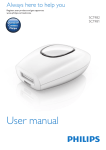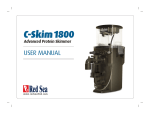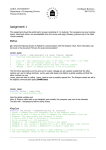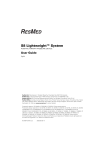Download Registered No. 4263359 0608 Page 1 Customer Guide to
Transcript
Customer Guide to KindWater 742TC 14 Litre Water Softener Email: [email protected] Tel: 0845 2600 420 (weekdays 9.15-5.00) KindWater Water Tower Yard Presmere Road Pettistree, Woodbridge Suffolk IP13 0HZ Softened water with the minimum cost and effort Enjoying softened water is easy. This guide will answer many of your questions. If you need further help or more salt, please contact us during office hours. When will I start getting softened water? Straight away from taps that feed directly from your KindWater softener. Try the cold water at your kitchen sink first. However it may take a week or so before all the hard water in your tanks is replaced with softened water. The change may seem gradual as your new softened water dilutes the old hard water. How do I know if it is working? Try washing your hands and you should feel the difference that softened water makes. You will soon get used to the silky feel of softened water and be quick to notice if it goes hard. Softened water leaves your skin so smooth that at first you may think that the soap hasn’t rinsed off. In fact soap rinses off faster with softened water and leaves your skin cleaner because there is no scum in the water. It is your skin’s natural moisturiser that makes it feel slippery. For this reason more care may be required getting in and out of the bath. So what do I have to do? Your KindWater softener is fully automatic. You just need to add some more granular or tablet salt every few weeks. To do this lift the salt lid off and look inside. If you can’t see any salt you have probably run out and will soon get hard water. To refill just pour or scoop some salt in. Try not to let the salt level fall below a few inches from the bottom and if possible avoid filling it right to the top But don’t worry if you do run out - the worst that will happen is a few days of hard water. You can stop putting salt in your dishwasher and start to cut down on washing machine detergent. Softened water is not suitable for all steam irons. Never use softened water to mix powdered baby milk. Powdered formula milk for babies already contains the correct level of sodium. The additional sodium in softened water may cause young babies to become dehydrated. So please only use hard water to mix infant formula milk. Warranty KindWater softeners are the most cost-effective and reliable single-cylinder water softeners available. Your softener comes with a 1 year parts and labour warranty. This includes our installation work. Your softener should give you 10 or more years of softened water with only a limited need for servicing. Registered No. 4263359 0608 Page 1 Softened water in your home and garden Your environment Softened water means no more limescale removers and much less detergent, washing up liquid, cleaning products, soaps and shampoos. It also means that you can use pure soap products, without the anti-hardness chemicals added to fight aggressive hard water. The quality of eco-friendly detergents, washing-up liquids and cleaning products does vary, but with softened water they are well worth a try. And you should find that because you are not paying for the antihardness chemicals, you save money as well as the environment. Your skin and hair You will get a silky feel after washing, because softened water doesn’t dry out your body’s natural oils. At first this may make you think that you haven’t rinsed the soap off. Actually you rinse clean faster with softened water, with no scum to stick to your skin and hair. Your skin will feel smoother and you will be able to use less shampoo and conditioner to get softer hair. Try using pure soaps like Simple. You will be able to wet shave without skin irritation. Your clothes and towels Your colours really will stay brighter and your whites whiter. And with no hard water to damage the fabrics, clothes will look and feel great for longer. You will need much less detergent with softened water, perhaps less than half of what you are used to using. Eco-friendly or non-biological detergents will give the greatest savings. Fabric conditioner can also be cut in half or even eliminated altogether, although this will increase static cling in tumble-dryers and ironing. To bring new life to your towels you may want to wash them a couple of times with no detergent at all. This will wash out the powder from previous washes. Older towels and clothes may be too damaged to feel soft, even with soft water washing. Descaling taps and surfaces With softened water you will notice that bathrooms and kitchens stay cleaner with less effort. If you would like to remove some of the old scale, try using limescale removing cleaning products, taking care to follow the manufacturer’s instructions. Another approach is to dampen a cloth with vinegar and then soak the fitting overnight. Vinegar is mildly acidic, making it easier to rub off scale in the morning. However several treatments may be required and care should be taken not to damage the surfaces of plastic or acrylic baths. Regrettably only scrubbing with a wire wool scouring pad seems to clean scale off glass shower screens. Descaling your plumbing and hot water cylinder You will be glad to know that softened water will dissolve the scale inside your plumbing. This will mean lower energy and repair bills. It may also mean that your hot water remains slightly hard for a month or two, as the scale in your hot water cylinder dissolves away. Registered No. 4263359 0608 Page 2 Your central heating system Softened water with a corrosion inhibitor (like Fernox) is the best combination for your central heating system. But there is no point in making a special effort to drain and refill the system any sooner than you would otherwise have done. Your washing machine Softened water will clean the scale off your washing machine heating element, so no need for Calgon and one less reason to call the repair man. Unless your washing machine is very new, you should check your water pump filter a couple of times over the first few weeks. The filter will trap any old scale that breaks off the heater element, so it may become obstructed if there is a lot of scale. Your kettle Unless your doctor has placed you on a low sodium diet, we suggest that you use softened water in your kettle. Your kettle will descale in just a few weeks and while the kettle element may turn black, this is completely harmless. Your tea and coffee will taste stronger and smoother. It will also look better because it will no longer be cloudy or covered in a layer of scum. And teapots, cups and spoons will no longer stain. Your dishwasher If you have a dishwasher, you can stop putting salt into its built in water softener. Reset the water hardness level to zero or ignore the salt refill indicator. And no need to buy those expensive dishwasher tablets with “built in salt effect”. Indoor plants Some plants do not like softened water. If you are unsure, use rain or hard water. Aquaria Fish do not like a sudden change in water quality so the water should only be replaced a quarter of a tank at a time. Some marine and tropical fish require special water conditions and so we recommend that you consult your supplier before changing from your existing water supply. Watering the garden Most outdoor plants are unaffected by softened water as long as the soil also receives occasional rainfall (to wash excess minerals out of the soil). However using softened water in the garden will waste soft water. If your outside tap is supplied through your KindWater softener directly from the mains, then you can always bypass your KindWater softener while watering the garden. Washing cars and windows Washing cars and windows with softened water saves polishing away the streaks and smears left by hard water as it dries. Registered No. 4263359 0608 Page 3 How does it work? How do water softeners work? When water flows through a water softener, the calcium (from limescale) is removed and replaced by sodium (from salt). Your water is now softened. After a few days the water softener needs to be recharged (regenerated) by using a salt solution to wash away the calcium. This is why the salt is slowly used up. Because regeneration happens automatically, all that you need to do is add some salt every few weeks. Don’t worry if you occasionally let your KindWater softener run out of salt. Apart from getting some hard water, no harm will be done. And the water softener will make sure that you never get salt in your water. How does my KindWater softener work? The electric power supply runs a digital clock. The display on the front shows the current water flow rate and a reading showing the nominal capacity of the water softener. At 2 a.m. on the programmed nights, your KindWater softener automatically regenerates. This takes one hour. During this time your water supply is hard. Your settings The settings below should be right for your water use and hardness. If either of these increases significantly you may need to change these settings and buy more salt (see the “What if…” section). As shown in the table on page 7, your KindWater softener has been set to: This means that it should use approximately: Level …… using …… g/l of salt every …… days. ……… kg of salt each year. In the unlikely event of a leak or overflow: 1 Bypass the softener 2 Turn off the power 3 Call KindWater (during office hours) Supply date ………………… Young children love to play with buttons. They are unlikely to do any harm, but they may change the settings. This will mean either that you get hard water or start using more salt than is needed. Children are locked out of most of the settings. However they may change the TIME OF DAY, DAY OF THE WEEK, TIME OF REGEN, MAXIMUM REGERATION INTERVAL or SALT AMOUNT. To check and reset, press the SQUARE button repeatedly until the desired setting is flashing. Use the arrows to change the setting. Finally press the SQUARE button again to confirm the change. It will reset after a short wait. Registered No. 4263359 0608 Page 4 How do I… Disconnect the drinking water tap from the water supply? The water supply to your drinking water tap is through a small plastic tube (normally blue). Follow this from the tap to your water pipe and you will find a small valve or tap connection. Turn this off to disconnect the water to your drinking water tap. Bypass my KindWater softener? Turn the blue valves across the pipes. These are now closed and your KindWater softener is disconnected from the water supply. Turn the central “bypass” valve (grey or red) in line with the pipe work. This is now open, allowing hard water to flow directly to your home. Check and reset the time clock? Your water softener has a digital 24 hour clock. If this is wrong your KindWater softener will regenerate at the wrong time of day. To check and reset the clock, press the SQUARE button once and the TIME OF DAY will flash. You can now use the arrows to change the time. When you have finished, press the SQUARE button. The display will shortly return to normal mode. Set my KindWater softener to regenerate at a different time of day? Press the SQUARE button five times. The TIME OF REGEN will flash. You can now use the arrows to change the time. When you have finished, press the SQUARE button. The display will shortly return to normal mode. Check or change the number of days between regenerations? Press the SQUARE button seven times. The REGEN INTERVAL will flash. The reading will show the number of days’ interval between regenerations. You can now use the arrows to change the amount. When you have finished, press the SQUARE button. The display will shortly return to normal mode. Increase or decrease the amount of salt used per regeneration? Press the SQUARE button nine times. The SALT AMOUNT will flash. The display should be 70 g/l, 90 g/l or 120 g/l. You can now use the arrows to change the amount. When you have finished, press the SQUARE button. The display will shortly return to normal mode. N.B. If you forget to press the SQUARE button after changing a setting, your changes will not be saved. Registered No. 4263359 0608 Page 5 Have I got a problem? If you can’t solve the problem yourself, please call us for advice on whether you need a service visit. If it is outside of office hours, switch off the power supply and bypass your softener (see page 5). My water appears cloudy… Fill a glass with water and you should see it clear from the bottom upwards. This is because the cloudiness is caused by small air bubbles in the water. They are completely harmless and some people find that they improve the taste of the water. These air bubbles result from the way that the water flows through the resin bed (in the middle of your KindWater softener) during regeneration. I can hear the sound of rushing water in my water softener… This is probably the sound of your KindWater softener regenerating. This should take place at 2 a.m. but the time on your water softener may be wrong or you may have knocked the REGEN button (a triangle made up of three arrows). However if the power supply to the water softener is off, bypass the softener until the power is back on. If the water softener has power but the regeneration does not stop within 75 minutes, hold in the REGEN button for 10 seconds and wait a further 75 minutes. If this does not work, bypass the water softener and call KindWater. I seem to be using a lot of salt… Check how often your KindWater softener is set to regenerate and how much salt it is set to use each time. If the settings are different to those on page 4, reset them. My water doesn’t feel completely softened… i. Check that your KindWater softener hasn’t been unplugged or switched off at the wall. ii. Check that you haven’t run out of salt (you need at least 3 or 4 inches to work properly). iii. Have you used more water than usual over the last couple of days? If this happens regularly you may need to increase your softening capacity (see below). iv. Has someone changed how often your water softener is set to regenerate (see settings on page 4). v. Has someone changed the amount of salt used per regeneration (see settings on page 4). vi. Is there a blockage or restriction in the drain into which the water softener discharges? vii. Is there a blockage around the brine draw tube? If there is a lot of very fine salt (like table salt) in the bottom of the cabinet, it will stop the brine being sucked up for regeneration. You will need to scoop out and throw away the salt in the cabinet and then refill with new salt. You may want to tell your salt supplier and consider using a different brand of salt. There is water on the floor around my water softener or installation point… Try to identify the source of the leak by looking and feeling for wetness. i. There are three hoses coming out of the back of the valve. These are the inlet hose, the outlet hose and the drain hose. If any these are poorly attached they may leak. Bypass your KindWater softener and try to reattach the hose more securely. ii. The inlet and outlet hoses are connected to the inlet and outlet valves. If these are poorly attached they may leak and should be bypassed and then reconnected more securely. iii. The sink drain may begin to leak if disturbed during installation. iv. The hard water drinking tap may start to leak if the plastic tube comes loose at either end or the washer fails. Isolate the tap (page 5) and repair. There is water dripping out of the overflow pipe in the outside wall… This indicates that there is too much salt or water in the cabinet. i. Check the level of salt in the cabinet. If it is within a few inches of the salt lid, this may be the cause of the problem. Try scooping some of the salt out to reduce the level. ii. Check that the brine draw tube hasn’t got blocked by fine salt at the bottom of the cabinet. If there is a lot of water in the cabinet and your water has gone hard, this is probably the cause. You will need to scoop out and throw away the salt and then refill with new salt. You may want to tell your salt supplier and consider using a different brand of salt. Registered No. 4263359 0608 Page 6 What if… There is a slight green stain under my taps… This is not common and is the result of poor pipe-work leaching copper into the water. I have a power cut… Your KindWater water softener has a capacitor back up (similar to a built in rechargeable battery) that will keep the clock running for at least 8 hours. If the power is off for longer than this, reset the TIME to ensure that it regenerates at 2 a.m. and the DAY OF THE WEEK (see settings on page 4). My KindWater softener runs out of salt… Just fill it up and it will begin to soften your water again after the next regeneration. I am going away for several weeks… You may want to switch your KindWater softener off to save salt while you are away. You need to switch off the power supply and turn the three valves (inlet, outlet and bypass). Then when you come back - turn the three valves, switch on the power, reset the time on the clock and manually start regeneration by pressing the REGEN button (a triangle made up of three arrows). I have a lot of people to stay and want extra softened water… There is a manual regeneration option. Press the REGEN button (a triangle made up of three arrows). Your KindWater softener will regenerate that night at 2 a.m. If you have several guests stay for several days, you may wish to do this every day of their stay. I want to increase my softening capacity… To get a long-term increase in the amount of water that your KindWater softener can soften, you will need to increase either the frequency of regeneration or the amount of salt used each time (see page 5). The table below shows the recommended sequence of settings and the approximate salt requirement for each. Level Days between each regeneration Salt amount per regeneration Approximate annual salt use Max water capacity p.a. at 300 ppm Max water capacity p.a. at 450 ppm 1 2 3 4 5 6 7 8 9 10 12 6 4 3 3 2 2 1 1 1 90 g/l 90 g/l 90 g/l 90 g/l 120 g/l 90 g/l 120 g/l 70 g/l 90 g/l 120 g/l 41 kg 82 kg 123 kg 164 kg 219 kg 246 kg 329 kg 383 kg 493 kg 657 kg 45 m3 90 m3 135 m3 180 m3 210 m3 270 m3 315 m3 420 m3 540 m3 630 m3 30 m3 60 m3 90 m3 120 m3 140 m3 180 m3 210 m3 280 m3 360 m3 420 m3 If you do change your settings please make a note on page 4 of this customer guide. I plan to move house… Unplug the power supply and bypass your KindWater softener. Disconnect the hoses (remembering that there will be some water in them as well as in your KindWater softener). Scoop out any remaining salt and water from the cabinet. Please contact KindWater if you would like our help with installation at your new home. If you would prefer not to transport and reinstall an ageing KindWater softener, it is worth offering it as a valuable extra to the purchasers of your old home. We will be pleased to advise you on the best model for your new home. Registered No. 4263359 0608 Page 7 Drinking Water Drinking softened water There is sodium in all drinking water, but there is more in softened water than in hard water. This need not concern you unless your doctor has placed you on a low-sodium diet. In fact milk contains 5-times as much sodium as softened water. Never use softened water to mix powdered baby milk. Bottled hard water is mineral water (spring water is naturally soft). Hard water is a minor source of dietary calcium (the best sources are green vegetables and dairy products) - but it makes terrible hot drinks and makes vegetables rubbery and shrivelled. So you may prefer to use softened water in your kettle and for cooking. Tap Unless you have a Reverse Osmosis drinking water system, your drinking tap is plumbed to your hard water supply. Filters KindWater supply a taste and odour filter for easy connection to your hard water drinking tap. This is highly convenient and great value if you currently spend money on bottled water or jug filters – or if you would like to improve the taste of your drinking water. If you have requested it, KindWater will automatically post out a replacement filter every 6/12 months. To replace the old filter simply: 1. 2. 3. 4. 5. 6. 7. 8. Turn off the inlet tap or saddle valve which is connected to your copper hard water pipe. [You can find this by following the plastic tube running out of the bottom of your water filter.] Turn on your hard water drinking tap to drain any water. [This will only take a few seconds.] Remove the old filter from the clip holding it to the wall. Place a bowl beneath the old filter to catch any splashes of remaining water. Take one end of the old filter, push in the small ring surrounding the tube and pull the tube out. Repeat for the other end. Throw the old filter away. An arrow on the side of the new filter shows the direction that the water should flow through the filter. Take the free end of the (usually blue) tube leading from the tap and insert it in the out end of the filter (the end nearer the tip of the arrow). Then take the free end of the other tube leading from the copper pipe and insert it in the in end of the filter. Tug each tube gently to check that they are secure. Place the new filter in the wall clip. Turn on the inlet tap or saddle valve. Water should start to flow through the filter and out of the hard water drinking tap. This will be dark for a few seconds while it rinses clean. Check that there is no leaking at either end of the filter. Turn off the hard water drinking tap. Outside tap To prevent the outside tap freezing during winter, close the indoors tap and open the outdoors tap. For use in winter, temporarily open the indoors tap. Feedback We trust that you love your softened water, find it great value and have enjoyed excellent service from KindWater. Please do recommend us to your family and friends. If you are disappointed in any way, please tell us so that we can try to put it right - or at least learn from our mistakes. Thank you for your custom. Registered No. 4263359 0608 Page 8








